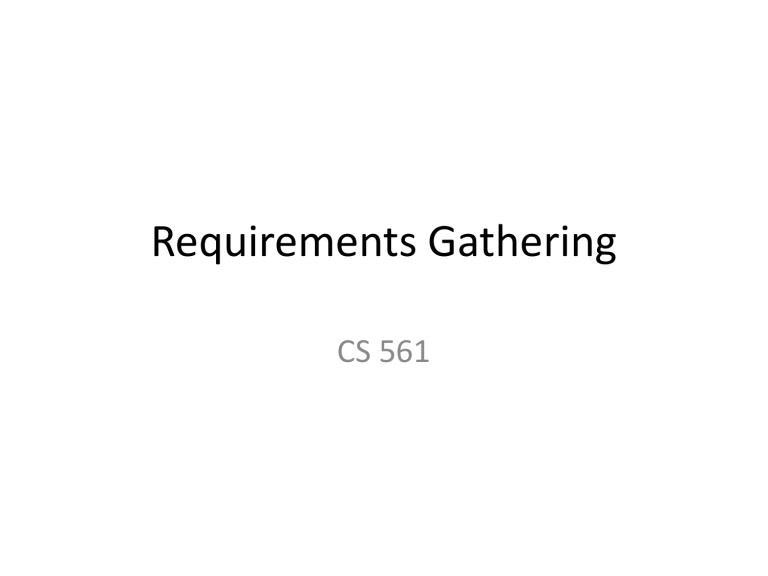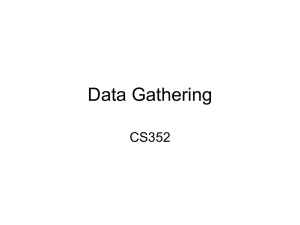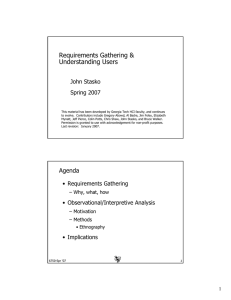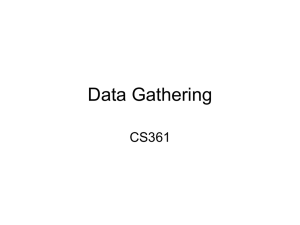Requirements Gathering CS 561

Requirements Gathering
CS 561
Where do Requirements Come From?
• Handed to you (?)
• Dialogue with
– Customer
– User
Are these always the same?
Are these always in agreement?
• Study of users/business/work environment
• Marketing research
• Existing documentation
• …
Avoiding Conflicting Requirements
Avoiding Miscommunication of
Requirements
Studying Users
• Questionnaires
• Interviews
• Focus groups
• Naturalistic observation
– Ethnomethodological
– Contextual inquiry
– Participatory design
• Structured
– Efficient
– Require training
• Unstructured
– Inefficient
– No training
• Semi-structured
– Good balance
– Often appropriate
Interviews
Semi-Structured Interviews
• Predetermine data of interest - know why you are asking questions - don’t waste time
• Plan for effective question types
• How do you perform task x?
• Why do you perform task x?
• Under what conditions do you perform task x?
• What do you do before you perform…?
• What information do you need to…?
• Whom do you need to communicate with to …?
• What do you use to…?
• What happens after you…?
• What is the result or consequence of…?
• What is the result or consequence of NOT…?
Guidelines
• Stay concrete
– “So when the new guy joined the team and hadn’t got his email account set up yet, what happened then?” vs. “What generally happens here when someone new joins the team?”
• Signs to look for
– Interviewee waves hands expansively and looks up at ceiling => generalization coming
– Use of passive voice, “generally”, “usually”, “should”, “might.”
Focus Groups
• Similar to interviews, except whole group interacts together
• Useful for discussion, introducing different viewpoints and contrasting opinions
• Sometimes combined with quizzes/surveys (!)
• Potential pitfalls
– Group-think
– Dominant characters
– Rationalization
Surveys
• General criteria
– Make questions clear and specific
– Ask some closed questions with range of answers
• Sometimes also have a no opinion option, or other answer option
– Do test run with two or three people
Surveys - Example
• Seven-point Likert Scale (use odd #)
Evaluation Qu estionnaire
Ple ase comp lete th e followi ng q u estion nai re b y in d icat in g h ow stron gl y you agr ee or di sagre e w ith the followi ng s tateme nt s. You r res p on ses wi ll be k ep t con fid en tial a nd wil l be u sed on ly for im p roving the int er face th at you w orke d with in this e xp erim en t.
1. I felt t h at the com p ut er agen t’s h elp w as w orthw hile.
2. I fou nd the co m p u ter a gen t to be intrusive.
1-----2------3------4------5------6------7
Stro ngly Stro ngly
Disa gree Agr ee
1-----2------3------4------5------6------7
Stro ngly Stro ngly
Disa gree Agr ee
3. I fou nd the co m p u ter a gen t's help to be distracting.
1-----2------3------4------5------6------7
Stro ngly Stro ngly
Disa gree Ag ree
• Could also use just words
– Strongly agree, agree, neutral, disagree, strongly disagree, less “flexible”
Other Typical Questions
• Rank the importance of each of these tasks (give a list of tasks)
• List the four most important tasks that you perform
(this is an open question)
• List the pieces of information you need to have before making a decision about X, in order of importance
• Are there any other points you would like to make?
(open-ended opinion question; good way to end)
Typical Open-Ended Questions
• Why do you do this (whatever the task is you are studying)
• How do you do this?
– Gets at task-subtask structure
– Then ask about each subtask
• Why do it this way rather than some other way?
– Attempts to get user to explain method so you can assess importance of the particular way of doing task
• What has to be done before you can do this?
– To understand sequencing requirements
Think-Aloud Study
• User describes verbally what s/he is thinking while performing the tasks
• What they believe is happening
• Why they take an action
• What they are trying to do
– Researcher takes notes about task and actions
• Very widely used, useful technique
• Potential problems:
– Can be awkward for participant
– Can modify way user performs task
Alternative
• What if thinking aloud during session will be too disruptive?
• Can use post-event protocol
– User performs session, then watches video and describes what s/he was thinking
– Sometimes difficult to recall
– Opens up door of interpretation
Related: Diary studies
• Subject asked to keep a journal of their daily activities
– Record actions, reasons, any other observations
• Not always subjective but prevents researcher from having to be everywhere 24/7
Observations
We are observing the:
• Space
– Description
– Meaning
– Appropriateness
• Objects
– Description
– Meaning
– Appropriateness
• People/activities
– Description
– Meaning
– Success/failure
• Technology
– Description
– Purpose
– Success/failure
On Space
Space: Appropriateness
People (desc)
My first “victim” was a male between 19/22 years old. He was about 5.9 feet tall and he was thin. He was wearing khaki short and a black T-shirt. He had black sport shoes. He was carrying with him his skate board. He had a big black back pack but it seemed almost empty. He had a lot of brown curly hair.
Because of his age and his skate board, I assumed he was a student; he “looked like” all the other teens. Furthermore, he seemed to know exactly where he was going, what he was looking for and how to get it. He never stopped during the time he was there and never gave the impression to be lost.
Actions (desc)
At 4:40pm, he came in from the A entrance and was looking toward the computer area. He decided to take a right just after Section 2. He walked a few steps and stopped. I assumed he realized no more desks were available in this are. It didn’t bother him, he didn’t feel embarrassed and turned back and went back from where he entered the area. He didn’t hesitate once then because he had seen a free desk.
He chose to sit down in the Section 2 on a stool.




